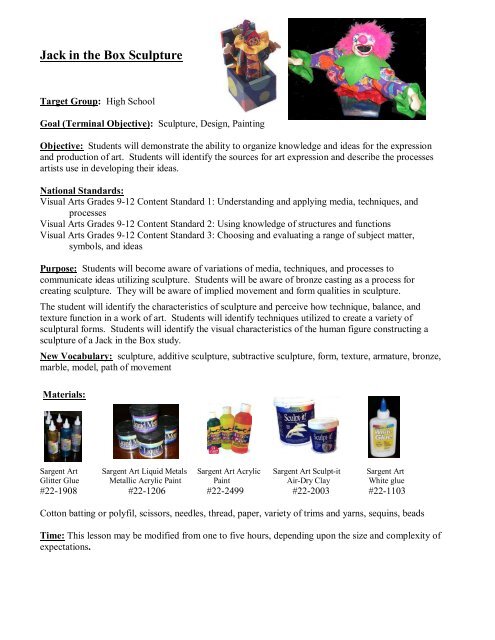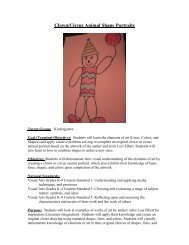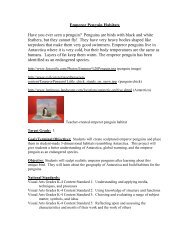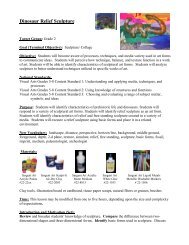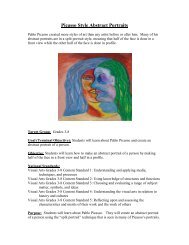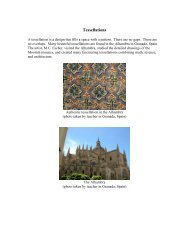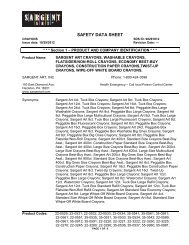Jack in the Box Sculpture - Sargent Art
Jack in the Box Sculpture - Sargent Art
Jack in the Box Sculpture - Sargent Art
Create successful ePaper yourself
Turn your PDF publications into a flip-book with our unique Google optimized e-Paper software.
<strong>Jack</strong> <strong>in</strong> <strong>the</strong> <strong>Box</strong> <strong>Sculpture</strong><br />
Target Group: High School<br />
Goal (Term<strong>in</strong>al Objective): <strong>Sculpture</strong>, Design, Pa<strong>in</strong>t<strong>in</strong>g<br />
Objective: Students will demonstrate <strong>the</strong> ability to organize knowledge and ideas for <strong>the</strong> expression<br />
and production of art. Students will identify <strong>the</strong> sources for art expression and describe <strong>the</strong> processes<br />
artists use <strong>in</strong> develop<strong>in</strong>g <strong>the</strong>ir ideas.<br />
National Standards:<br />
Visual <strong>Art</strong>s Grades 912 Content Standard 1: Understand<strong>in</strong>g and apply<strong>in</strong>g media, techniques, and<br />
processes<br />
Visual <strong>Art</strong>s Grades 912 Content Standard 2: Us<strong>in</strong>g knowledge of structures and functions<br />
Visual <strong>Art</strong>s Grades 912 Content Standard 3: Choos<strong>in</strong>g and evaluat<strong>in</strong>g a range of subject matter,<br />
symbols, and ideas<br />
Purpose: Students will become aware of variations of media, techniques, and processes to<br />
communicate ideas utiliz<strong>in</strong>g sculpture. Students will be aware of bronze cast<strong>in</strong>g as a process for<br />
creat<strong>in</strong>g sculpture. They will be aware of implied movement and form qualities <strong>in</strong> sculpture.<br />
The student will identify <strong>the</strong> characteristics of sculpture and perceive how technique, balance, and<br />
texture function <strong>in</strong> a work of art. Students will identify techniques utilized to create a variety of<br />
sculptural forms. Students will identify <strong>the</strong> visual characteristics of <strong>the</strong> human figure construct<strong>in</strong>g a<br />
sculpture of a <strong>Jack</strong> <strong>in</strong> <strong>the</strong> <strong>Box</strong> study.<br />
New Vocabulary: sculpture, additive sculpture, subtractive sculpture, form, texture, armature, bronze,<br />
marble, model, path of movement<br />
Materials:<br />
<strong>Sargent</strong> <strong>Art</strong> <strong>Sargent</strong> <strong>Art</strong> Liquid Metals <strong>Sargent</strong> <strong>Art</strong> Acrylic <strong>Sargent</strong> <strong>Art</strong> Sculptit <strong>Sargent</strong> <strong>Art</strong><br />
Glitter Glue Metallic Acrylic Pa<strong>in</strong>t Pa<strong>in</strong>t AirDry Clay White glue<br />
#221908 #221206 #222499 #222003 #221103<br />
Cotton batt<strong>in</strong>g or polyfil, scissors, needles, thread, paper, variety of trims and yarns, sequ<strong>in</strong>s, beads<br />
Time: This lesson may be modified from one to five hours, depend<strong>in</strong>g upon <strong>the</strong> size and complexity of<br />
expectations.
Introduction and Motivation (Set):<br />
View referenced websites to analyze exemplars of a variety of sculptural techniques. View <strong>the</strong> works of<br />
contemporary sculptors such as Red Grooms and Sandy Skoglund. Discuss how <strong>the</strong>se artists have used<br />
<strong>the</strong>ir art form to convey contemporary <strong>the</strong>mes.<br />
Discuss <strong>the</strong> observed differences of a variety of additive and subtractive sculptural exemplars.<br />
Analyze <strong>the</strong> artist’s use of materials and application of elements and pr<strong>in</strong>ciples <strong>in</strong> sculptural forms.<br />
Focus on bronze sculptures of <strong>the</strong> human figure. Compare and contrast those sculptures with <strong>the</strong> work<br />
of Henry Moore, Duane Hanson, George Segal, and Sandy Skoglund.<br />
Instruction:<br />
View sculptures and assist <strong>in</strong> discussion of how forms blend toge<strong>the</strong>r, but look as if <strong>the</strong>y might have<br />
been made by assembl<strong>in</strong>g or jo<strong>in</strong><strong>in</strong>g parts. Identify exemplars which have a more solid look and those<br />
that <strong>in</strong>fer movement. Describe <strong>the</strong> cast<strong>in</strong>g process and provide examples.<br />
Study Sir Henry Moore’s Family Group sculpture. Guide students to view how forms touch each o<strong>the</strong>r,<br />
provid<strong>in</strong>g <strong>the</strong> <strong>in</strong>ference of strength. View examples of Greek and Roman sculptures of <strong>the</strong> human form,<br />
make contrasts <strong>in</strong> process (clay versus carv<strong>in</strong>g <strong>in</strong> marble or cast<strong>in</strong>g <strong>in</strong> bronze).<br />
Introduce <strong>the</strong> <strong>Jack</strong> <strong>in</strong> <strong>the</strong> <strong>Box</strong> model. Relate <strong>the</strong> task of creat<strong>in</strong>g such a model as a clown figure or a<br />
figure created as a selfportrait.<br />
Activities:<br />
(1) Guided Practice:<br />
1. Students create sketches of humans, focus on <strong>the</strong> upper torso.<br />
2. Students are asked to consider what k<strong>in</strong>d of action <strong>the</strong> figure could show utiliz<strong>in</strong>g just <strong>the</strong><br />
arms of <strong>the</strong> figure.<br />
3. Students plan design for box which will hold figure.<br />
4. Students use sculptural techniques to sculpt a head on a liter soda bottle out of Sculptit,<br />
mak<strong>in</strong>g sure <strong>the</strong> head is firmly pressed <strong>in</strong>to <strong>the</strong> neck of <strong>the</strong> bottle.<br />
5. Students cut <strong>the</strong> top off a square facial tissue box. Students use papier mache techniques to<br />
cover <strong>the</strong> sides of <strong>the</strong> box and let dry.<br />
6. Students glue bottle to bottom of box.
(2) Independent Practice and Check for Understand<strong>in</strong>g: Teacher circulates among work<strong>in</strong>g students<br />
visually record<strong>in</strong>g students demonstrat<strong>in</strong>g understand<strong>in</strong>g of objectives and provides re<strong>in</strong>forcement.<br />
1. Students use <strong>Sargent</strong> Liquid Metal Acrylics, <strong>Sargent</strong> Acrylic Pa<strong>in</strong>t, pa<strong>in</strong>t box.<br />
2. Students use a variety of colors to create visual <strong>in</strong>terest.<br />
3. Students use a variety of patterns to create surface design.<br />
Students complete <strong>the</strong> follow<strong>in</strong>g steps:<br />
4. Us<strong>in</strong>g wire create armature for arms by twist<strong>in</strong>g length of wire around neck of bottle.<br />
5. Wrap arms with fiberfill to provide bulk. Bend arms to <strong>in</strong>dicate gesture.<br />
6. Cover arms with rectangles of fabric scraps dipped <strong>in</strong> a mixture of 1 part water to 3 parts <strong>Sargent</strong><br />
white glue. Cover torso with large rectangle of fabric scrap dipped <strong>in</strong> <strong>the</strong> same glue/water<br />
mixture. Allow to dry.<br />
7. Pa<strong>in</strong>t facial features.<br />
8. Glue fake fur or yarn for hair.<br />
9. Head ware may be made out of paper, felt, or fabric scraps.
10. Details can be provided with found objects, beads, sequ<strong>in</strong>s, or trims.<br />
11. Edges of box around figure can be stuffed <strong>in</strong>to <strong>the</strong> open<strong>in</strong>gs between bottle and box.<br />
(3) Closure: Students record ei<strong>the</strong>r by checklist or writ<strong>in</strong>g prompt, <strong>the</strong> symbols used, <strong>the</strong> connection to<br />
<strong>the</strong> exemplar and <strong>the</strong> <strong>in</strong>novations <strong>the</strong>y provided to <strong>the</strong> piece.<br />
Evaluation: Teacher/student critique and/or <strong>in</strong>dividual evaluation.<br />
Extension: This strategy may be extended to a written class project provid<strong>in</strong>g biography or narrative<br />
about <strong>the</strong> character <strong>in</strong> <strong>the</strong> box.<br />
Resources:<br />
http://www.sculpture.org/documents/scmag07/may_07/may07.shtml<br />
http://en.wikipedia.org/wiki/<strong>Sculpture</strong><br />
http://sculpture.net/community/<br />
http://www.pbs.org/hanshofmann/red_grooms_works_001.html<br />
http://www.sandyskoglund.com/<br />
http://en.wikipedia.org/wiki/Sandy_Skoglund<br />
http://www.saatchigallery.co.uk/artists/duane_hanson.htm<br />
http://en.wikipedia.org/wiki/Duane_Hanson<br />
http://en.wikipedia.org/wiki/Henry_Moore<br />
BY JANE STRICKER<br />
<strong>Art</strong> Consultant<br />
________________________________________________________________________________________<br />
www.sargentart.com 09/22/07


